The great white shark has no known natural predators other than, on very rare occasions, the killer whale.[12] The great white shark is arguably the world's largest known extant macropredatory fish, and is one of the primary predators of marine mammals, up to the size of large baleen whales. It is also known to prey upon a variety of other marine animals, including fish, and seabirds. It is the only known surviving species of its genus Carcharodon, and is responsible for more recorded human bite incidents than any other shark.[13][14]
The species faces numerous ecological challenges which has resulted in international protection. The IUCN lists the great white shark as a vulnerable species,[2] and it is included in Appendix II of CITES.[15] It is also protected by several national governments such as Australia (as of 2018).[16]
The novel Jaws by Peter Benchley and its subsequent film adaptation by Steven Spielberg depicted the great white shark as a "ferocious man eater". Humans are not the preferred prey of the great white shark,[17] but the great white is nevertheless responsible for the largest number of reported and identified fatal unprovoked shark attacks on humans.[18]

Taxonomy
This section may be confusing or unclear to readers. (June 2018) (Learn how and when to remove this template message)
|
Ancestry and fossil record
The earliest known fossils of the great white shark are about 16 million years old, during the mid-Miocene epoch.[1][irrelevant citation] However, the phylogeny of the great white is still in dispute. The original hypothesis for the great white's origins is that it shares a common ancestor with a prehistoric shark, such as the C. megalodon. C. megalodon had teeth that were superficially not too dissimilar with those of great white sharks, but its teeth were far larger. Although cartilaginous skeletons do not fossilize, C. megalodon is estimated to have been considerably larger than the great white shark, estimated at up to 17 m (56 ft) and 59,413 kg (130,983 lb).[21] Similarities among the physical remains and the extreme size of both the great white and C. megalodon led many scientists to believe these sharks were closely related, and the name Carcharodon megalodon was applied to the latter. However, a new hypothesis proposes that the C. megalodon and the great white are distant relatives (albeit sharing the family Lamnidae). The great white is also more closely related to an ancient mako shark, Isurus hastalis, than to the C. megalodon, a theory that seems to be supported with the discovery of a complete set of jaws with 222 teeth and 45 vertebrae of the extinct transitional species Carcharodon hubbelli in 1988 and published on 14 November 2012.[22] In addition, the new hypothesis assigns C. megalodon to the genus Carcharocles, which also comprises the other megatoothed sharks; Otodus obliquus is the ancient representative of the extinct Carcharocles lineage.[23]Distribution and habitat
Shark off Guadalupe Island, Mexico
The great white is an epipelagic fish, observed mostly in the presence of rich game, such as fur seals (Arctocephalus ssp.), sea lions, cetaceans, other sharks, and large bony fish species. In the open ocean, it has been recorded at depths as great as 1,200 m (3,900 ft).[11] These findings challenge the traditional notion that the great white is a coastal species.[11]
According to a recent study, California great whites have migrated to an area between Baja California Peninsula and Hawaii known as the White Shark Café to spend at least 100 days before migrating back to Baja. On the journey out, they swim slowly and dive down to around 900 m (3,000 ft). After they arrive, they change behavior and do short dives to about 300 m (980 ft) for up to ten minutes. Another white shark that was tagged off the South African coast swam to the southern coast of Australia and back within the year. A similar study tracked a different great white shark from South Africa swimming to Australia's northwestern coast and back, a journey of 20,000 km (12,000 mi; 11,000 nmi) in under nine months.[27] These observations argue against traditional theories that white sharks are coastal territorial predators, and open up the possibility of interaction between shark populations that were previously thought to have been discrete. The reasons for their migration and what they do at their destination is still unknown. Possibilities include seasonal feeding or mating.[28]
In the Northwest Atlantic the white shark populations off the New England coast were nearly eradicated due to over-fishing.[29] However, in recent years the populations have begun to grow greatly,[30] largely due to the increase in seal populations on Cape Cod, Massachusetts since the enactment of the Marine Mammal Protection Act in 1972.[31] Currently very little is known about the hunting and movement patterns of great whites off Cape Cod, but ongoing studies hope to offer insight into this growing shark population.[32]
A 2018 study indicated that white sharks prefer to congregate deep in anticyclonic eddies in the North Atlantic Ocean. The sharks studied tended to favor the warm water eddies, spending the daytime hours at 450 meters and coming to the surface at night.[33]
Anatomy and appearance
Great white shark near Gansbaai, showing upper and lower teeth
Size
In great white sharks, sexual dimorphism is present, and females are generally larger than males. Male great whites on average measure 3.4 to 4.0 m (11 to 13 ft) long, while females at 4.6 to 4.9 m (15 to 16 ft).[6] Adults of this species weigh 522–771 kg (1,151–1,700 lb) on average,[39] however mature females can have an average mass of 680–1,110 kg (1,500–2,450 lb).[4] The largest females have been verified up to 6.1 m (20 ft) in length and an estimated 1,905 kg (4,200 lb) in weight,[3][4] perhaps up to 2,268 kg (5,000 lb).[5] The maximum size is subject to debate because some reports are rough estimations or speculations performed under questionable circumstances.[40] Among living cartilaginous fish, only the whale shark (Rhincodon typus), the basking shark (Cetorhinus maximus) and the giant manta ray (Manta birostris), in that order, are on average larger and heavier. These three species are generally quite docile in disposition and given to passively filter-feeding on very small organisms.[39] This makes the great white shark the largest extant macropredatory fish. Great white sharks are at around 1.2 m (3.9 ft) when born, and grow about 25 cm (9.8 in) each year.[41]
According to J. E. Randall, the largest white shark reliably measured was a 6.0 m (19.7 ft) individual reported from Ledge Point, Western Australia in 1987.[42] Another great white specimen of similar size has been verified by the Canadian Shark Research Center: A female caught by David McKendrick of Alberton, Prince Edward Island, in August 1988 in the Gulf of St. Lawrence off Prince Edward Island. This female great white was 6.1 m (20 ft) long.[4] However, there was a report considered reliable by some experts in the past, of a larger great white shark specimen from Cuba in 1945.[38][43][44][45] This specimen was reportedly 6.4 m (21 ft) long and had a body mass estimated at 3,324 kg (7,328 lb).[38][44] However, later studies also revealed that this particular specimen was actually around 4.9 m (16 ft) in length, a specimen in the average maximum size range.[4]
The largest great white recognized by the International Game Fish Association (IGFA) is one caught by Alf Dean in south Australian waters in 1959, weighing 1,208 kg (2,663 lb).[40] Several larger great whites caught by anglers have since been verified, but were later disallowed from formal recognition by IGFA monitors for rules violations.
Examples of large unconfirmed great whites
A number of very large unconfirmed great white shark specimens have been recorded.[46] For decades, many ichthyological works, as well as the Guinness Book of World Records, listed two great white sharks as the largest individuals: In the 1870s, a 10.9 m (36 ft) great white captured in southern Australian waters, near Port Fairy, and an 11.3 m (37 ft) shark trapped in a herring weir in New Brunswick, Canada, in the 1930s. However, these measurements were not obtained in a rigorous, scientifically valid manner, and researchers have questioned the reliability of these measurements for a long time, noting they were much larger than any other accurately reported sighting. Later studies proved these doubts to be well founded. This New Brunswick shark may have been a misidentified basking shark, as the two have similar body shapes. The question of the Port Fairy shark was settled in the 1970s when J. E. Randall examined the shark's jaws and "found that the Port Fairy shark was of the order of 5.0 m (16.4 ft) in length and suggested that a mistake had been made in the original record, in 1870, of the shark's length".[42] These wrong measurements would make the alleged shark more than five times heavier than it really was.One contender in maximum size among the predatory sharks is the tiger shark (Galeocerdo cuvier). While tiger sharks which are typically both a few feet smaller and have a leaner, less heavy body structure than white sharks, have been confirmed to reach at least 5.5 m (18 ft) in the length, an unverified specimen was reported to have measured 7.4 m (24 ft) in length and weighed 3,110 kg (6,860 lb), more than two times heavier than the largest confirmed specimen at 1,524 kg (3,360 lb).[39][56][57] Some other macropredatory sharks such as the Greenland shark (Somniosus microcephalus) and the Pacific sleeper shark (S. pacificus) are also reported to rival these sharks in length (but probably weigh a bit less since they are more slender in build than a great white) in exceptional cases.[58][59] The question of maximum weight is complicated by the unresolved question of whether or not to include the shark's stomach contents when weighing the shark. With a single bite a great white can take in up to 14 kg (31 lb) of flesh and can also consume several hundred kilograms of food.
Adaptations
A great white shark swimming
Shark biting into the fish head teaser bait next to a cage in False Bay, South Africa
Toxicity from heavy metals seems to have little negative effects on great white sharks. Blood samples taken from forty-three individuals of varying size, age and sex off the South African coast led by biologists from the University of Miami in 2012 indicates that despite high levels of mercury, lead, and arsenic, there was no sign of raised white blood cell count and granulate to lymphocyte ratios, indicating the sharks had healthy immune systems. This discovery suggests a previously unknown physiological defense against heavy metal poisoning. Great whites are known to have a propensity for "self-healing and avoiding age-related ailments".[65]
Bite force
A 2007 study from the University of New South Wales in Sydney, Australia, used CT scans of a shark's skull and computer models to measure the shark's maximum bite force. The study reveals the forces and behaviors its skull is adapted to handle and resolves competing theories about its feeding behavior.[66] In 2008, a team of scientists led by Stephen Wroe conducted an experiment to determine the great white shark's jaw power and findings indicated that a specimen massing 3,324 kg (7,328 lb) could exert a bite force of 18,216 newtons (4,095 lbf).[44]Ecology and behavior
A shark turns onto its back while hunting tuna bait
The great white shark is one of only a few sharks known to regularly lift its head above the sea surface to gaze at other objects such as prey. This is known as spy-hopping. This behavior has also been seen in at least one group of blacktip reef sharks, but this might be learned from interaction with humans (it is theorized that the shark may also be able to smell better this way because smell travels through air faster than through water). White sharks are generally very curious animals, display intelligence and may also turn to socializing if the situation demands it. At Seal Island, white sharks have been observed arriving and departing in stable "clans" of two to six individuals on a yearly basis. Whether clan members are related is unknown, but they get along peacefully enough. In fact, the social structure of a clan is probably most aptly compared to that of a wolf pack; in that each member has a clearly established rank and each clan has an alpha leader. When members of different clans meet, they establish social rank nonviolently through any of a variety of interactions.[68]
Diet
Great white sharks are carnivorous and prey upon fish (e.g. tuna, rays, other sharks),[68] cetaceans (i.e., dolphins, porpoises, whales), pinnipeds (e.g. seals, fur seals,[68] and sea lions), sea turtles,[68] sea otters (Enhydra lutris) and seabirds.[69] Great whites have also been known to eat objects that they are unable to digest. Juvenile white sharks predominantly prey on fish, including other elasmobranchs, as their jaws are not strong enough to withstand the forces required to attack larger prey such as pinnipeds and cetaceans until they reach a length of 3 m (9.8 ft) or more, at which point their jaw cartilage mineralizes enough to withstand the impact of biting into larger prey species.[70] Upon approaching a length of nearly 4 m (13 ft), great white sharks begin to target predominantly marine mammals for food, though individual sharks seem to specialize in different types of prey depending on their preferences.[71][72] They seem to be highly opportunistic.[73][74] These sharks prefer prey with a high content of energy-rich fat. Shark expert Peter Klimley used a rod-and-reel rig and trolled carcasses of a seal, a pig, and a sheep from his boat in the South Farallons. The sharks attacked all three baits but rejected the sheep carcass.[75]
Off California, sharks immobilize northern elephant seals (Mirounga angustirostris) with a large bite to the hindquarters (which is the main source of the seal's mobility) and wait for the seal to bleed to death. This technique is especially used on adult male elephant seals, which are typically larger than the shark, ranging between 1,500 and 2,000 kg (3,300 and 4,400 lb), and are potentially dangerous adversaries.[76][77] Most commonly though, juvenile elephant seals are the most frequently eaten at elephant seal colonies.[78] Prey is normally attacked sub-surface. Harbor seals (Phoca vitulina) are taken from the surface and dragged down until they stop struggling. They are then eaten near the bottom. California sea lions (Zalophus californianus) are ambushed from below and struck mid-body before being dragged and eaten.[79]
In the Northwest Atlantic mature great whites are known to feed on both harbor and grey seals.[31] Unlike adults, juvenile white sharks in the area feed on smaller fish species until they are large enough to prey on marine mammals such as seals.[80]
White sharks also attack dolphins and porpoises from above, behind or below to avoid being detected by their echolocation. Targeted species include dusky dolphins (Lagenorhynchus obscurus),[47] Risso's dolphins (Grampus griseus),[47] bottlenose dolphins (Tursiops ssp.),[47][81] Humpback dolphins (Sousa ssp.),[81] harbour porpoises (Phocoena phocoena),[47] and Dall's porpoises (Phocoenoides dalli).[47] Groups of dolphins have occasionally been observed defending themselves from sharks with mobbing behaviour.[81] White shark predation on other species of small cetacean has also been observed. In August 1989, a 1.8 m (5.9 ft) juvenile male pygmy sperm whale (Kogia breviceps) was found stranded in central California with a bite mark on its caudal peduncle from a great white shark.[82] In addition, white sharks attack and prey upon beaked whales.[47][81] Cases where an adult Stejneger's beaked whale (Mesoplodon stejnegeri), with a mean mass of around 1,100 kg (2,400 lb),[83] and a juvenile Cuvier's beaked whale (Ziphius cavirostris), an individual estimated at 3 m (9.8 ft), were hunted and killed by great white sharks have also been observed.[84] When hunting sea turtles, they appear to simply bite through the carapace around a flipper, immobilizing the turtle. The heaviest species of bony fish, the oceanic sunfish (Mola mola), has been found in great white shark stomachs.[73]
Off Seal Island, False Bay in South Africa, the sharks ambush brown fur seals (Arctocephalus pusillus) from below at high speeds, hitting the seal mid-body. They can go so fast that they completely leave the water. The peak burst speed is estimated to be above 40 km/h (25 mph).[85] They have also been observed chasing prey after a missed attack. Prey is usually attacked at the surface.[86] Shark attacks most often occur in the morning, within 2 hours of sunrise, when visibility is poor. Their success rate is 55% in the first 2 hours, falling to 40% in late morning after which hunting stops.[68]
A shark scavenging on a whale carcass in False Bay, South Africa
Stomach contents of great whites also indicates that whale sharks both juvenile and adult may also be included on the animal's menu, though whether this is active hunting or scavenging is not known at present.[90][91]
Reproduction
Great white sharks were previously thought to reach sexual maturity at around 15 years of age, but are now believed to take far longer; male great white sharks reach sexual maturity at age 26, while females take 33 years to reach sexual maturity.[9][92][93] Maximum life span was originally believed to be more than 30 years, but a study by the Woods Hole Oceanographic Institution placed it at upwards of 70 years. Examinations of vertebral growth ring count gave a maximum male age of 73 years and a maximum female age of 40 years for the specimens studied. The shark's late sexual maturity, low reproductive rate, long gestation period of 11 months and slow growth make it vulnerable to pressures such as overfishing and environmental change.[8]Little is known about the great white shark's mating habits, and mating behavior has not yet been observed in this species. It is possible that whale carcasses are an important location for sexually mature sharks to meet for mating.[87] Birth has never been observed, but pregnant females have been examined. Great white sharks are ovoviviparous, which means eggs develop and hatch in the uterus and continue to develop until birth.[94] The great white has an 11-month gestation period. The shark pup's powerful jaws begin to develop in the first month. The unborn sharks participate in oophagy, in which they feed on ova produced by the mother. Delivery is in spring and summer.[95] The largest number of pups recorded for this species is 14 pups from a single mother measuring 4.5 m (15 ft) that was killed incidentally off Taiwan in 2019.[96] The Northern Pacific population of great whites is suspected to breed off the Sea of Cortez, as evidenced by local fisherman who have said to have caught them and evidenced by teeth found at dump sites for discarded parts from their catches.[citation needed]
Breaching behavior
Great white shark breaching near Gansbaai in South Africa
Natural threats
Comparison of the size of an average orca and an average great white shark
Conservation status
It is unclear how much of a concurrent increase in fishing for great white sharks has caused the decline of great white shark populations from the 1970s to the present. No accurate global population numbers are available, but the great white shark is now considered vulnerable.[2] Sharks taken during the long interval between birth and sexual maturity never reproduce, making population recovery and growth difficult.The IUCN notes that very little is known about the actual status of the great white shark, but as it appears uncommon compared to other widely distributed species, it is considered vulnerable.[2] It is included in Appendix II of CITES,[15] meaning that international trade in the species requires a permit.[108] As of March 2010, it has also been included in Annex I of the CMS Migratory Sharks MoU, which strives for increased international understanding and coordination for the protection of certain migratory sharks.[109] A February 2010 study by Barbara Block of Stanford University estimated the world population of great white sharks to be lower than 3,500 individuals, making the species more vulnerable to extinction than the tiger, whose population is in the same range.[110] According to another study from 2014 by George H. Burgess, Florida Museum of Natural History, University of Florida, there are about 2,000 great white sharks near the California coast, which is 10 times higher than the previous estimate of 219 by Barbara Block.[111][112]
Fishermen target many sharks for their jaws, teeth, and fins, and as game fish in general. The great white shark, however, is rarely an object of commercial fishing, although its flesh is considered valuable. If casually captured (it happens for example in some tonnare in the Mediterranean), it is misleadingly sold as smooth-hound shark.[113]
In Australia
The great white shark was declared Vulnerable by the Australian Government in 1999 because of significant population decline and is currently protected under the Environmental Protection and Biodiversity Conservation (EPBC) Act.[114] The causes of decline prior to protection included mortality from sport fishing harvests as well as being caught in beach protection netting.[115]The national conservation status of the great white shark is reflected by all Australian states under their respective laws, granting the species full protection throughout Australia regardless of jurisdiction.[114] Many states had prohibited the killing or possession of great white sharks prior to national legislation coming into effect. The great white shark is further listed as Threatened in Victoria under the Flora and Fauna Guarantee Act, and as rare or likely to become extinct under Schedule 5 of the Wildlife Conservation Act in Western Australia.[114]
In 2002, the Australian government created the White Shark Recovery Plan, implementing government-mandated conservation research and monitoring for conservation in addition to federal protection and stronger regulation of shark-related trade and tourism activities.[115] An updated recovery plan was published in 2013 to review progress, research findings, and to implement further conservation actions.[16] A study in 2012 revealed that Australia's White Shark population was separated by Bass Strait into genetically distinct eastern and western populations, indicating a need for the development of regional conservation strategies.[116]
Presently, human-caused shark mortality is continuing, primarily from accidental and illegal catching in commercial and recreational fishing as well as from being caught in beach protection netting, and the populations of great white shark in Australia are yet to recover.[16]
In spite of official protections in Australia, great white sharks continue to be killed in state "shark control" programs within Australia. For example, the government of Queensland has a "shark control" program (shark culling) which kills great white sharks (as well as other marine life) using shark nets and drum lines with baited hooks.[117][118] In Queensland, great white sharks that are found alive on the baited hooks are shot.[119] The government of New South Wales also kills great white sharks in its "shark control" program.[118] Partly because of these programs, shark numbers in eastern Australia have decreased.[120]
The Australasian population of great white sharks is believed to be in excess of 8,000-10,000 individuals according to genetic research studies done by CSIRO, with an adult population estimated to be around 2,210 individuals in both Eastern and Western Australia. The annual survival rate for juveniles in these two separate populations was estimated in the same study to be close to 73 percent, while adult sharks had a 93 percent annual survival rate. Whether or not mortality rates in great white sharks have declined, or the population has increased as a result of the protection of this species in Australian waters is as yet unknown due to the slow growth rates of this species.[121]
In New Zealand
As of April 2007, great white sharks were fully protected within 370 km (230 mi) of New Zealand and additionally from fishing by New Zealand-flagged boats outside this range. The maximum penalty is a $250,000 fine and up to six months in prison.[122] In June 2018 the New Zealand Department of Conservation classified the great white shark under the New Zealand Threat Classification System as "Nationally Endangered". The species meets the criteria for this classification as there exists a moderate, stable population of between 1000 and 5000 mature individuals. This classification has the qualifiers "Data Poor" and "Threatened Overseas".[123]In North America
In 2013, great white sharks were added to California's Endangered Species Act. From data collected, the population of great whites in the North Pacific was estimated to be fewer than 340 individuals. Research also reveals these sharks are genetically distinct from other members of their species elsewhere in Africa, Australia, and the east coast of North America, having been isolated from other populations.[124]A 2014 study estimated the population of great white sharks along the California coastline to be approximately 2,400.[125][126]
In 2015 Massachusetts banned catching, cage diving, feeding, towing decoys, or baiting and chumming for its significant and highly predictable migratory great white population without an appropriate research permit. The goal of these restrictions is to both protect the sharks and public health.[127]
Relationship with humans
Shark bite incidents
Of all shark species, the great white shark is responsible for by far the largest number of recorded shark bite incidents on humans, with 272 documented unprovoked bite incidents on humans as of 2012.[18]More than any documented bite incident, Peter Benchley's best-selling novel Jaws and the subsequent 1975 film adaptation directed by Steven Spielberg provided the great white shark with the image of being a "man eater" in the public mind.[128] While great white sharks have killed humans in at least 74 documented unprovoked bite incidents, they typically do not target them: for example, in the Mediterranean Sea there have been 31 confirmed bite incidents against humans in the last two centuries, most of which were non-fatal. Many of the incidents seemed to be "test-bites". Great white sharks also test-bite buoys, flotsam, and other unfamiliar objects, and they might grab a human or a surfboard to identify what it is.
The
great white shark is one of only four kinds of shark that have been
involved in a significant number of fatal unprovoked attacks on humans.
Humans are not appropriate prey because the shark's digestion is too slow to cope with a human's high ratio of bone to muscle and fat. Accordingly, in most recorded shark bite incidents, great whites broke off contact after the first bite. Fatalities are usually caused by blood loss from the initial bite rather than from critical organ loss or from whole consumption. From 1990 to 2011 there have been a total of 139 unprovoked great white shark bite incidents, 29 of which were fatal.[131]
However, some researchers have hypothesized that the reason the proportion of fatalities is low is not because sharks do not like human flesh, but because humans are often able to escape after the first bite. In the 1980s, John McCosker, Chair of Aquatic Biology at the California Academy of Sciences, noted that divers who dove solo and were bitten by great whites were generally at least partially consumed, while divers who followed the buddy system were generally rescued by their companion. McCosker and Timothy C. Tricas, an author and professor at the University of Hawaii, suggest that a standard pattern for great whites is to make an initial devastating attack and then wait for the prey to weaken before consuming the wounded animal. Humans' ability to move out of reach with the help of others, thus foiling the attack, is unusual for a great white's prey.[132]
Shark culling
Shark culling is the deliberate killing of sharks by a government in an attempt to reduce shark attacks; shark culling is often called "shark control".[118] These programs have been criticized by environmentalists and scientists — they say these programs harm the marine ecosystem; they also say such programs are "outdated, cruel, and ineffective".[133] Many different species (dolphins, turtles, etc.) are also killed in these programs (because of their use of shark nets and drum lines) — 15,135 marine animals were killed in New South Wales' nets between 1950 and 2008,[118] and 84,000 marine animals were killed by Queensland authorities from 1962 to 2015.[134]Great white sharks are currently killed in both Queensland and New South Wales in "shark control" (shark culling) programs.[118] Queensland uses shark nets and drum lines with baited hooks, while New South Wales only uses nets. From 1962 to 2018, Queensland authorities killed about 50,000 sharks, many of which were great whites.[120] From 2013 to 2014 alone, 667 sharks were killed by Queensland authorities, including great white sharks.[118] In Queensland, great white sharks found alive on the drum lines are shot.[119] In New South Wales, between 1950 and 2008, a total of 577 great white sharks were killed in nets.[118] Between September 2017 and April 2018, 14 great white sharks were killed in New South Wales.[135]
KwaZulu-Natal (an area of South Africa) also has a "shark control" program that kills great white sharks and other marine life. In a 30-year period, more than 33,000 sharks were killed in KwaZulu-Natal's shark-killing program, including great whites.[136]
In 2014 the state government of Western Australia led by Premier Colin Barnett implemented a policy of killing large sharks. The policy, colloquially referred to as the Western Australian shark cull, was intended to protect users of the marine environment from shark bite incidents, following the deaths of seven people on the Western Australian coastline in the years 2010–2013.[137] Baited drum lines were deployed near popular beaches using hooks designed to catch great white sharks, as well as bull and tiger sharks. Large sharks found hooked but still alive were shot and their bodies discarded at sea.[138] The government claimed they were not culling the sharks, but were using a "targeted, localised, hazard mitigation strategy".[139] Barnett described opposition as "ludicrous" and "extreme", and said that nothing could change his mind.[140] This policy was met with widespread condemnation from the scientific community, which showed that species responsible for bite incidents were notoriously hard to identify, that the drum lines failed to capture white sharks, as intended, and that the government also failed to show any correlation between their drum line policy and a decrease in shark bite incidents in the region.[141]
Attacks on boats
Great white sharks infrequently bite and sometimes even sink boats. Only five of the 108 authenticated unprovoked shark bite incidents reported from the Pacific Coast during the 20th century involved kayakers.[142] In a few cases they have bitten boats up to 10 m (33 ft) in length. They have bumped or knocked people overboard, usually biting the boat from the stern. In one case in 1936, a large shark leapt completely into the South African fishing boat Lucky Jim, knocking a crewman into the sea. Tricas and McCosker's underwater observations suggest that sharks are attracted to boats by the electrical fields they generate, which are picked up by the ampullae of Lorenzini and confuse the shark about whether or not wounded prey might be near-by.[143]In captivity
Great white shark in the Monterey Bay Aquarium in September 2006
Monterey Bay Aquarium first attempted to display a great white in 1984, but the shark died after 11 days because it did not eat.[145] In July 2003, Monterey researchers captured a small female and kept it in a large netted pen near Malibu for five days. They had the rare success of getting the shark to feed in captivity before its release.[146] Not until September 2004 was the aquarium able to place a great white on long-term exhibit. A young female, which was caught off the coast of Ventura, was kept in the aquarium's 3,800,000 l (1,000,000 US gal) Outer Bay exhibit for 198 days before she was released in March 2005. She was tracked for 30 days after release.[147] On the evening of 31 August 2006, the aquarium introduced a juvenile male caught outside Santa Monica Bay.[148] His first meal as a captive was a large salmon steak on 8 September 2006, and as of that date, he was estimated to be 1.72 m (68 in) in length and to weigh approximately 47 kg (104 lb). He was released on 16 January 2007, after 137 days in captivity.
Monterey Bay Aquarium housed a third great white, a juvenile male, for 162 days between 27 August 2007, and 5 February 2008. On arrival, he was 1.4 m (4.6 ft) long and weighed 30.6 kg (67 lb). He grew to 1.8 m (5.9 ft) and 64 kg (141 lb) before release. A juvenile female came to the Outer Bay Exhibit on 27 August 2008. While she did swim well, the shark fed only one time during her stay and was tagged and released on 7 September 2008. Another juvenile female was captured near Malibu on 12 August 2009, introduced to the Outer Bay exhibit on 26 August 2009, and was successfully released into the wild on 4 November 2009.[149] The Monterey Bay Aquarium added a 1.4 m (4.6 ft) long male into their redesigned "Open Sea" exhibit on 31 August 2011. The animal was captured in the waters off Malibu.
One of the largest adult great whites ever exhibited was at Japan's Okinawa Churaumi Aquarium in 2016, where a 3.5 m (11 ft) male was exhibited for three days before dying.[150][151] Probably the most famous captive was a 2.4 m (7.9 ft) female named Sandy, which in August 1980 became the only great white to be housed at the California Academy of Sciences' Steinhart Aquarium in San Francisco, California. She was released because she would not eat and constantly bumped against the walls.[152]
Shark tourism
Cage diving is most common at sites where great whites are frequent including the coast of South Africa, the Neptune Islands in South Australia,[153] and Guadalupe Island in Baja California. The popularity of cage diving and swimming with sharks is at the focus of a booming tourist industry.[154][155] A common practice is to chum the water with pieces of fish to attract the sharks. These practices may make sharks more accustomed to people in their environment and to associate human activity with food; a potentially dangerous situation. By drawing bait on a wire towards the cage, tour operators lure the shark to the cage, possibly striking it, exacerbating this problem. Other operators draw the bait away from the cage, causing the shark to swim past the divers.At present, hang baits are illegal off Isla Guadalupe and reputable dive operators do not use them. Operators in South Africa and Australia continue to use hang baits and pinniped decoys.[156] In South Australia, playing rock music recordings underwater, including the AC/DC album Back in Black has also been used experimentally to attract sharks.[157]
Companies object to being blamed for shark bite incidents, pointing out that lightning tends to strike humans more often than sharks bite humans.[158] Their position is that further research needs to be done before banning practices such as chumming, which may alter natural behavior.[159] One compromise is to only use chum in areas where whites actively patrol anyway, well away from human leisure areas. Also, responsible dive operators do not feed sharks. Only sharks that are willing to scavenge follow the chum trail and if they find no food at the end then the shark soon swims off and does not associate chum with a meal. It has been suggested that government licensing strategies may help enforce these responsible tourism.[156]
The shark tourist industry has some financial leverage in conserving this animal. A single set of great white jaws can fetch up to £20,000. That is a fraction of the tourism value of a live shark; tourism is a more sustainable economic activity than shark fishing. For example, the dive industry in Gansbaai, South Africa consists of six boat operators with each boat guiding 30 people each day. With fees between £50 and £150 per person, a single live shark that visits each boat can create anywhere between £9,000 and £27,000 of revenue daily.[citation needed]
- A great white shark approaches a cage


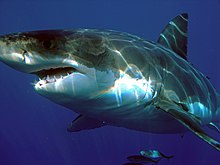



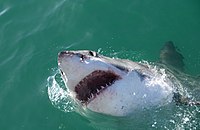
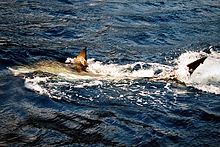

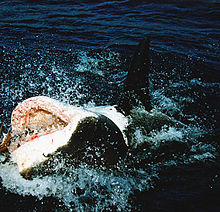


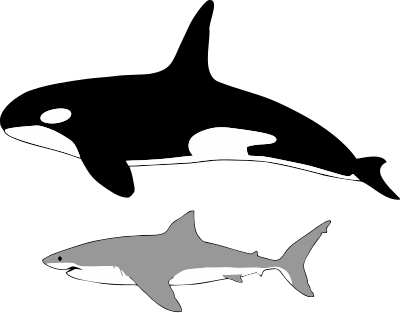

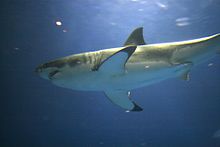
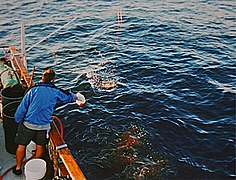




No comments:
Post a Comment
Note: Only a member of this blog may post a comment.